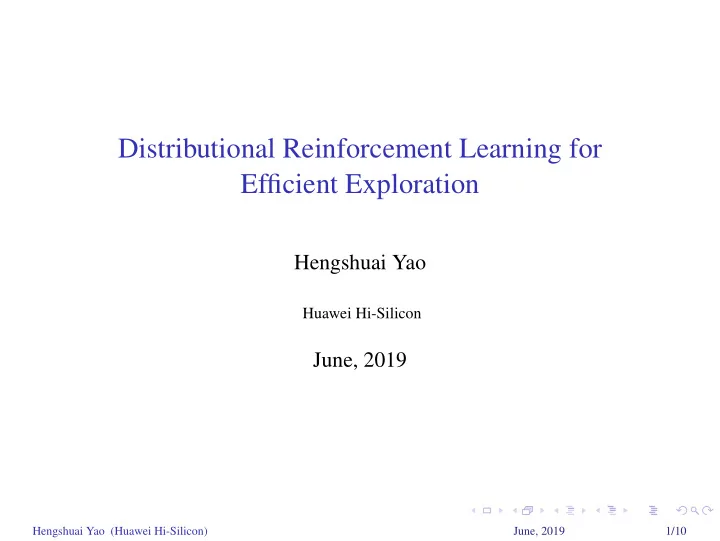

Distributional Reinforcement Learning for Efficient Exploration Hengshuai Yao Huawei Hi-Silicon June, 2019 Hengshuai Yao (Huawei Hi-Silicon) June, 2019 1/10
The exploration problem ◮ Exploration is a long standing problem in Reinforcement Learning. ◮ One major fundamental principle is optimism in the face of uncertainty. ◮ Both count-based methods and Bayesian methods follow this optimism principle. ◮ Here the uncertainty refers to parametric uncertainty , which arises from the variance in the estimates of certain parameters given finite samples. Hengshuai Yao (Huawei Hi-Silicon) June, 2019 2/10
Intrinsic uncertainties ◮ The estimation is not the only source of uncertainties. ◮ Most environment itself is stochastic. ◮ Even for deterministic game like GO, the opponent is a huge factor of uncertainty. ◮ The learning process can’t eliminate Intrinsic uncertainty. Hengshuai Yao (Huawei Hi-Silicon) June, 2019 3/10
A naive approach ◮ A naive approach to exploration would be to use the variance of the estimated distribution as a bonus. ◮ Consider a multi-armed bandit environment with 10 arms where each arm’s reward follows normal distribution N ( µ k , σ k ) . ◮ In the setting of multi-armed bandits, this approach leads to picking the arm a such that a = arg max µ k + c σ k ¯ (1) k µ k and σ 2 where ¯ k are the estimated mean and variance of the k -th arm, computed from the corresponding quantile distribution estimation. Hengshuai Yao (Huawei Hi-Silicon) June, 2019 4/10
The naive approach is not optimal Naive exploration bonus I n t r i n s i c u n c e r t a t i n t y P a r a m e t r i c u n c e r t a i n t y Time steps ◮ The naive approach favors actions with high intrinsic uncertainty forever. Hengshuai Yao (Huawei Hi-Silicon) June, 2019 5/10
The motivation of Decaying exploration bonus Decaying bonus I n t r i n s i c u n c e r t a t i n t y P a r a m e t r i c u n c e r t a i n t y Time steps ◮ To suppress the intrinsic uncertainty, we propose a decaying schedule in the form of a multiplier. Hengshuai Yao (Huawei Hi-Silicon) June, 2019 6/10
The DLTV exploration bonus ◮ For instantiating optimism in the face of uncertainty, the upper tail variability is more relevant than the lower tail. ◮ To increase stability, we use the left truncated measure of the variability, σ 2 + . ◮ By combining decaying schedule with σ 2 + we obtain a new exploration bonus for picking an action, which we call Decaying Left Truncated Variance (DLTV): � σ 2 c t + where � log t c t = c . t Hengshuai Yao (Huawei Hi-Silicon) June, 2019 7/10
Results ◮ Our approach achieved 483 % average gain in cumulative rewards on the set of 49 Atari games. ◮ None of the learning curves exhibit plummeting behaviour ◮ Notably the performance gain is obtained in hard games such as Venture, PrivateEye, Montezuma Revenge and Seaquest. DLTV QR-DQN-1 Hengshuai Yao (Huawei Hi-Silicon) June, 2019 8/10
Application on driving safety ◮ A particularly interesting application of the (Distributional) RL approach is driving safety. ◮ DLTV learns significantly faster than DQN and QR-DQN, achieving higher rewards for safety driving. Hengshuai Yao (Huawei Hi-Silicon) June, 2019 9/10
Summary ◮ Exploration is important. ◮ Principle is optimism in the face of uncertainty. ◮ Optimism without decaying is not optimal. ◮ Truncated measure is more stable. ◮ Combining them decaying schedule and truncated measure, we have DLTV. ◮ And it works. Hengshuai Yao (Huawei Hi-Silicon) June, 2019 10/10
Recommend
More recommend